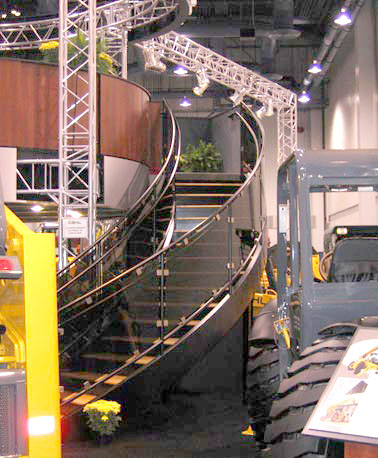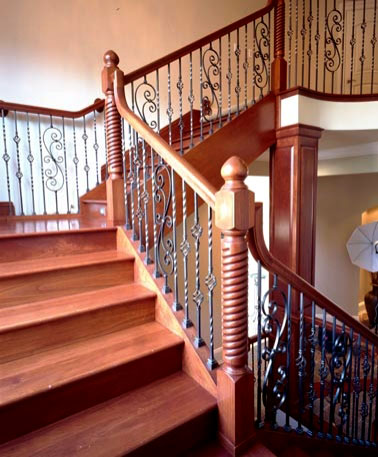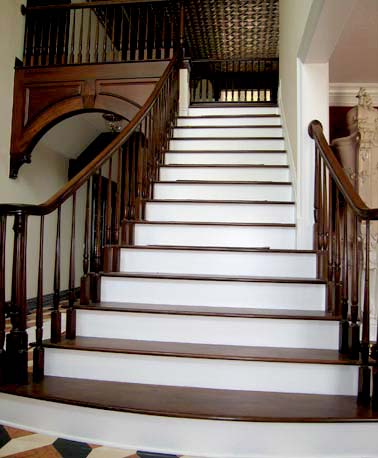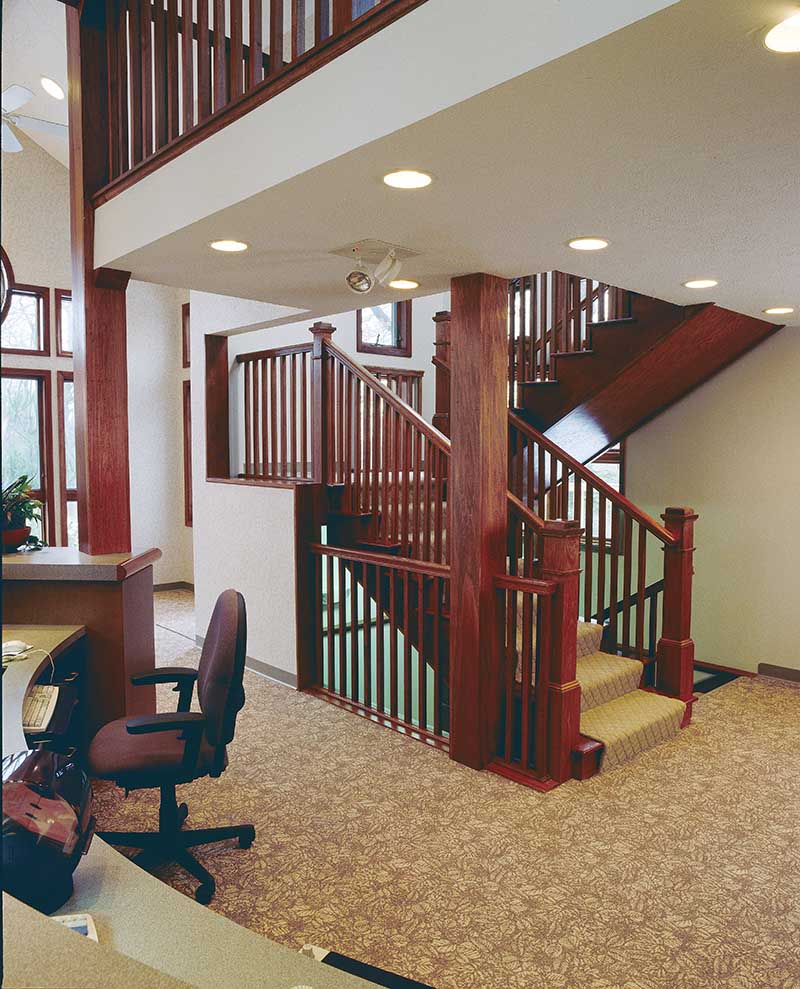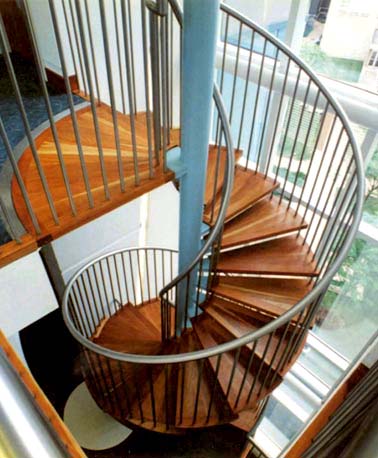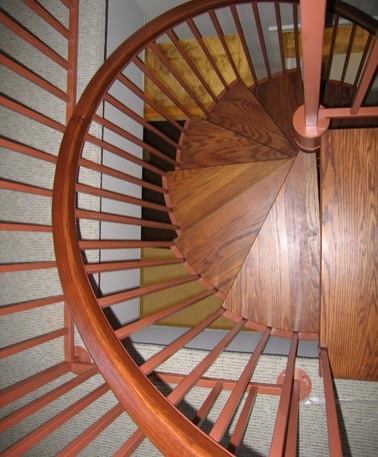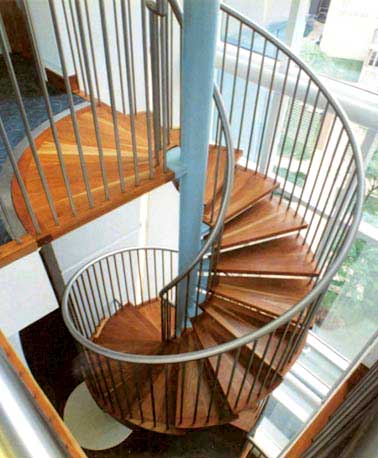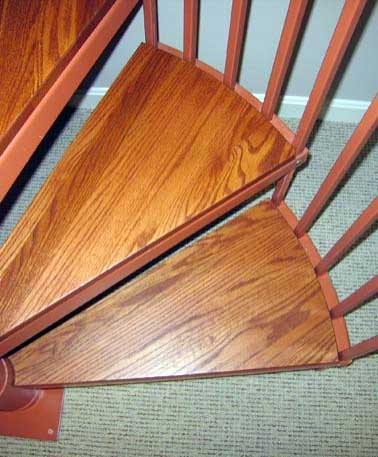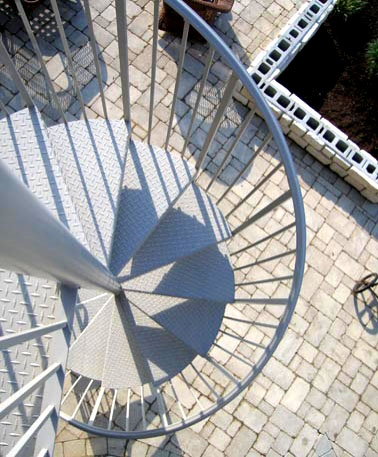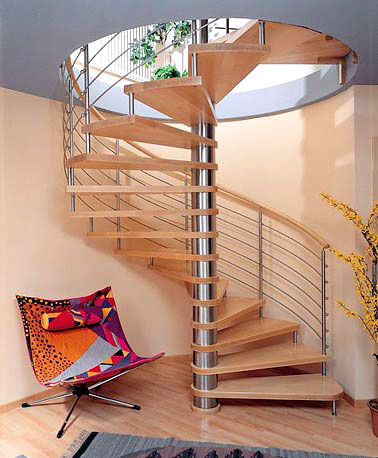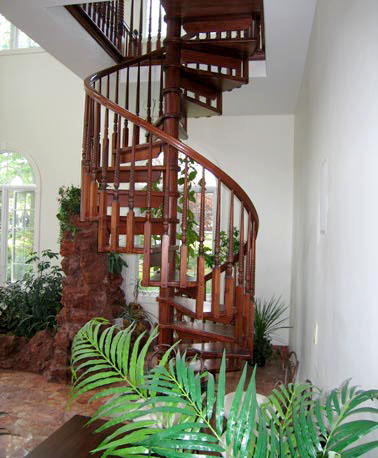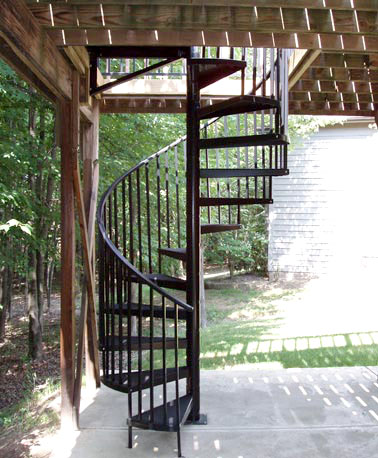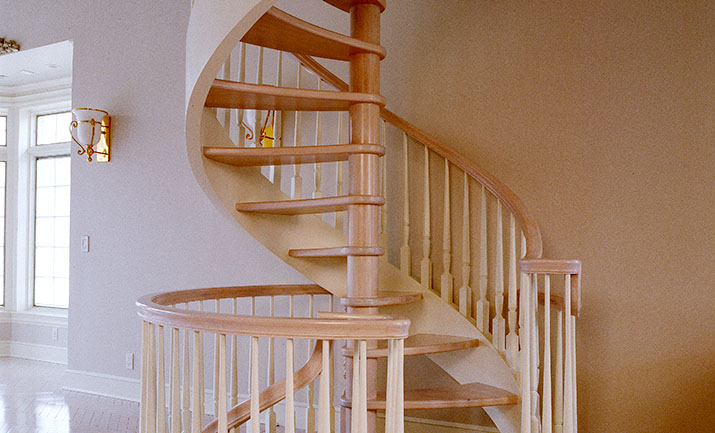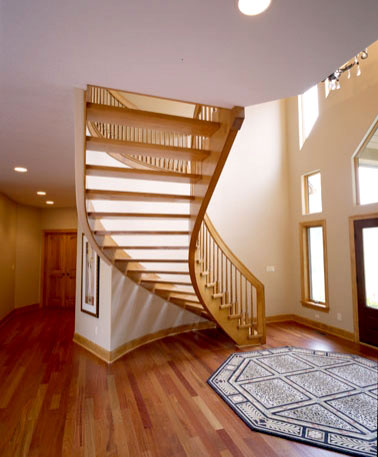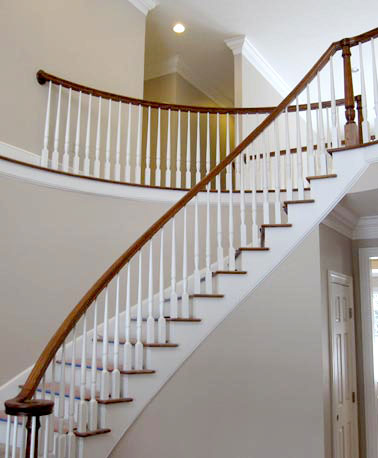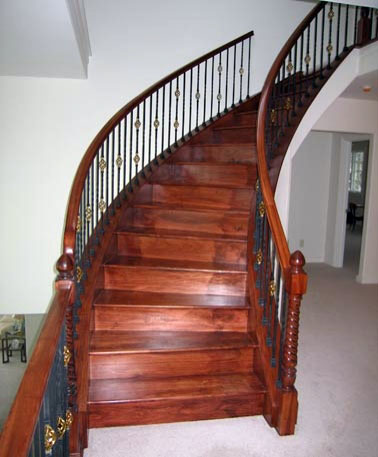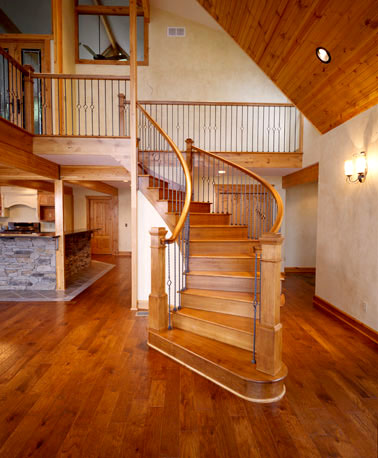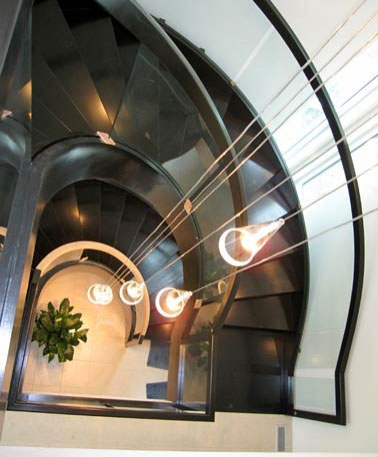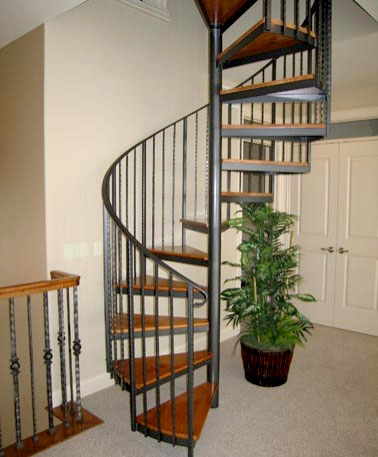Understanding Spiral Stairs
We at The Great Lakes Stair & Millwork Co., receive a wide variety of requests for many different styles and types of spiral stairs. We have designed and built many of these aesthetically different and exceptionally functional spiral staircase systems in the last 30 years of our extensive history. However, we have found that many people use the term “spiral stairs” almost generically, the same way the terms “tissue” and “Kleenex®” are often interchanged. We would like to take this opportunity to talk about spiral stairs, their advantages, disadvantages, and how they are different from other circular, curved or helical staircase systems.
What Is A Spiral Staircase, How Is It Different?
The term “spiral stair” is widely used (somewhat generic term) to describe a radius / diameter turning staircase such as a curved stair, circular stair, radiused stair, or a round stair. The implication is a staircase that does some type of radius turn. The actual definition of a spiral staircase is the following:
- A spiral staircase is a round stair system that uses a radius or diameter and wraps around a center pole.
Other turning staircases can be defined as:
- A circular staircase rotates in a round fashion around the circumference of a room. Usually turns more than 90 degrees
- A curved staircase does a sweeping turn in a smaller area that a circular stair and usually does not make a complete circle. Usually turns 90 degrees or less.
- A Helical stair is similar in size to a spiral stair, but does not use a center pole and typically has an inner and outer radius handrails.
- A winding staircase completes a turn with angles and does so with angular steps without a center pole.
Thus, the key differentiator between a spiral staircase and other types of turning stairs is that a spiral staircase wraps symmetrically around a center pole.
What Advantages Do Spiral Stairs Offer?
Spiral staircases are ideal to be used for ease of personal access in a small area. With a standard 5’-3” finish square opening, we can do a lot with a spiral staircase to traverse between floors with ease. Additionally, spiral staircases are great conversation pieces as they are aesthetically different from perpendicular or traditional staircases. You do not see spiral staircases all the time in the design of a home, so they tend to stand out when implemented. The best part about a spiral stair is that it does “a lot” in a “little” space while looking extremely architecturally aesthetic!
While we are big fans of spiral staircases here at Great Lakes Stair, there are some key points to keep in mind if you are considering implementing a spiral staircase system:
- Spiral stairs can not be used as the main staircase in a home or business.
- Spiral stairs are not deemed good as a fire escape and they also limit gurney and fire hose access.
- It is difficult, if not impossible, to move furniture between floors with a spiral staircase.
- Spiral stairs cannot be used as bedroom only access.
- Sometimes spiral staircases can be intimidating to people to traverse, especially seniors and young children and also pets.
If constructed and used properly, spiral stairs can be a beautiful and safe addition to your home or business where only personal access to an area is needed.
What are the disadvantages of a Spiral Staircases?
For the most part, a spiral staircase is an easy, attractive alternative to access a floor level in your home while utilizing minimal space. But, spiral stairs do have a few minimal disadvantages. We feel it is our responsibility as a Senior Stair Manufacturer in the United States to make you aware of any potential issues you may (OR MAY NOT) encounter with the addition of a spiral stair in your home or project;
- Spiral staircases tend to have higher rises per step (avg.9” per rise). This can be challenging for people with walking or climbing issues.
- Spiral stairs can be somewhat intimidating to the very young, elderly and pets.
- Spiral Stairways are somewhat difficult to carry objects (i.e. Laundry Basket) up and down the stair. Furniture is very difficult to carry or maneuver on a spiral stair.
- Spiral Stair systems cannot be used as primary access to bedroom areas due to fire codes.
- Spiral stairs, for the most part, cannot be used as a primary access in any home, building or outside structure where people live. Check with your local building department before implementing a spiral stair in your project.
- Spiral stair systems cannot be used as a primary fire escape stair residentially or commercially.
- The smaller the spiral stair, the more difficult to “walk straight” up or down. For example, you might have to walk a bit sideways up or down a 4’-0” diameter spiral stair depending on your size as a person.
- There might be a slight vibration or shimmy while walking on a spiral stair. This is completely normal.
- Spiral stairs are easier to walk up than to walk down.
- It may be difficult to “pass” another person on a spiral stair. Typically a spiral stair is a one user at a time stair.
While none of the above (potential) disadvantages of a spiral stair are monumental, it is only fair to make people aware that they could encounter none , some, or all of the above while determining if a Spiral Staircase System is right for them.
What Type Of Materials Can Be Used To Build A Spiral Staircase?
Typically, spiral staircases are constructed using all wood, all metal, or made with a combination of these materials. Additionally, spiral staircases can incorporate glass or decorative iron or both. Check out our spiral stair gallery for a wide variety of examples of spiral staircases we have made at Great Lakes Stair.
How Much Do Spiral Stairs Cost?
The cost for a spiral staircase, like any other staircase is relative to the overall design and materials used in the construction as well as installation considerations. You can design and build a cost-effective spiral staircase, or a luxury model. At Great Lakes Stair we will work closely with you and discuss your needs and evaluate your space and propose a spiral staircase solution that works for your home and your budget.
What sizes are available in spiral stairs?
The average spiral stair diameter is 5’-0”. This is predominantly the most widely used size for spiral stairs. The 5’-0” diameter meets most uniform building codes around the United states and neighboring countries for code adherence / compliance. This stair fits comfortably in a 5’-6” finish square or round opening.
Typical Spiral stair diameters can start out utilizing a 4’-0” diameter (we have even completed a 3’-6” diameter spiral stair for a Doll house), but can be made to virtually any diameter up to 12’-0”. After 12’ in diameter, you would be better off putting in a circular stair (see our article on Circular Stairs). The Most common spiral staircase sizes and their respective finished openings they fit in are as follows;
Stair Diameter desired Finish opening needed
- 4’-0”…………………………4’-6” x 4’x6” square or 4’6”diameter
- 4’-6” ………………………. 5’-0” x 5’-0” square or 5’-0” diameter
- 5’-0”…………………………5’-6”x 5’-6” square or 5’-6” diameter
- 5’-6”…………………………6’-0” x 6’-0” square or 6’-0” diameter
- 6’-0” ………………………..6’-6”x 6’-6” square or 6’-6” diameter
- Or any size in between or larger!
How is a Spiral Staircases delivered to my project or home? How do I get it inside the home?
These are great questions and also are great concerns when purchasing a Spiral Staircase system. We have all heard the horror stories of fully assembled spiral stairs arriving at a home or jobsite with no ability to get it inside structure. For most applications, this process of fully assembling spiral stairs prior to arrival and delivering them completely welded or fabricated in whole, is nothing short of a catastrophic disaster.
We at The Great Lakes Stair company do things differently than other manufacturers. Most of our spiral stairway applications will be Pre- built in our shop to ensure fit and finish and then disassembled in simple sections, numbered and labeled for ease of final jobsite installation. The stair will then be carefully packaged on a “skid”, wrapped in protective cardboard and shipped directly from our facility to your home or project. We can arrange for tailgate delivery anywhere in the US or neighboring Countries. From here, all you need is one person to carry the lightweight sections through a 2’-6” or larger door into the room or area where the spiral stair will be installed and then reassemble. 2 people are required for stair assembly, one to hold the center pole, the other person to slide the sections over the center pole. It’s that easy.
In general, most spiral stairs can be final assembled and installed in less than a working days time.
Why You Should Choose Great Lakes Stair For Your Spiral Staircase?
With over 30 years of experience in producing and installing spiral staircases, we know exactly what questions to ask about your project and we will understand your needs as a consumer. We collaborate with our customers by sharing photos, evaluating your space, understanding your specifications and then, turning your ideas into reality. We do not produce any base or entry level products, all our spiral staircase solutions range from semi-custom to all custom designed and hand fabricated projects. Remember, One size does not fit all when it comes to spiral stairs. The inexpensive commodity spiral stair market and cheap prices will only lead to problems. We routinely replace commodity spiral staircase kits that were poorly constructed and/or installed by unqualified individuals. Lastly, if it resembles a one size fits all “Erector Set” it typically is. Run far and fast as this is not the time to save minimal monies which will equate to a maximum headache.
Please give us a call at 330-225-2005 or contact us when you are considering purchasing a spiral staircase ; the specialists at The Great Lakes Stair Company will ensure you get the right spiral stair for your needs, at the right price for your budget along with optional expert installation for a spiral staircase that will last a lifetime.
